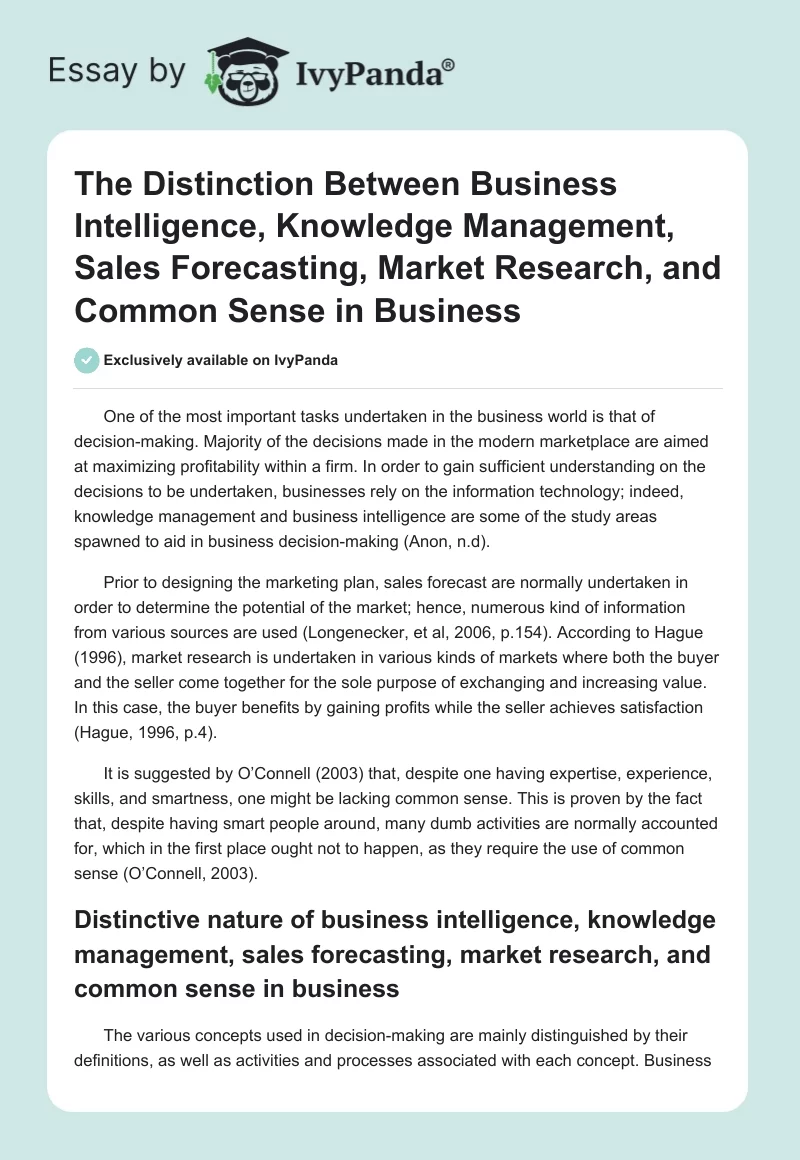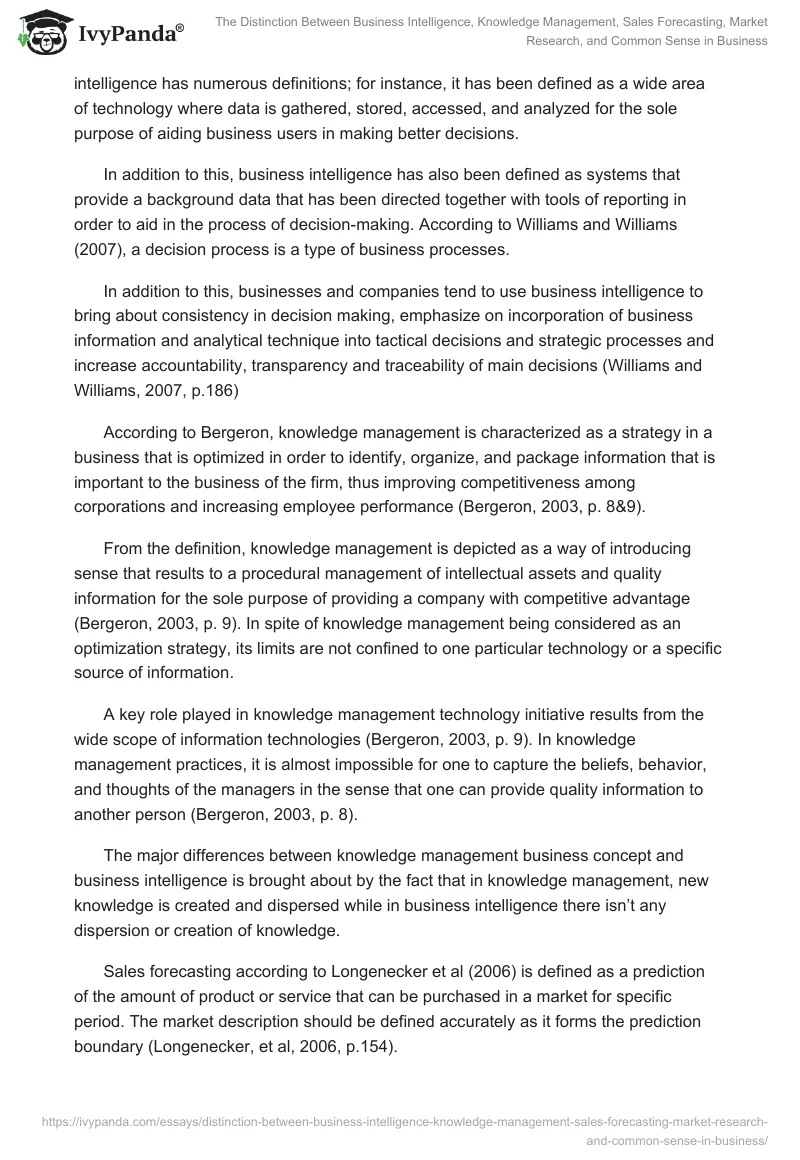Introduction
One of the most important tasks undertaken in the business world is that of decision-making. Majority of the decisions made in the modern marketplace are aimed at maximizing profitability within a firm. In order to gain sufficient understanding on the decisions to be undertaken, businesses rely on the information technology; indeed, knowledge management and business intelligence are some of the study areas spawned to aid in business decision-making (Anon, n.d).
Prior to designing the marketing plan, sales forecasts are normally undertaken in order to determine the potential of the market; hence, numerous kinds of information from various sources are used (Longenecker, et al, 2006, p.154). According to Hague (1996), market research is undertaken in various kinds of markets where both the buyer and the seller come together for the sole purpose of exchanging and increasing value. In this case, the buyer benefits by gaining profits while the seller achieves satisfaction (Hague, 1996, p.4).
It is suggested by O’Connell (2003) that, despite one having expertise, experience, skills, and smartness, one might be lacking common sense. This is proven by the fact that, despite having smart people around, many dumb activities are normally accounted for, which in the first place ought not to happen, as they require the use of common sense (O’Connell, 2003).
Concepts in Decision-Making
Business Intelligence
The various concepts used in decision-making are mainly distinguished by their definitions, as well as activities and processes associated with each concept. Business intelligence has numerous definitions; for instance, it has been defined as a wide area of technology where data is gathered, stored, accessed, and analyzed for the sole purpose of aiding business users in making better decisions.
In addition to this, business intelligence has also been defined as systems that provide a background data that has been directed together with tools of reporting in order to aid in the process of decision-making. According to Williams and Williams (2007), a decision process is a type of business process.
In addition to this, businesses and companies tend to use business intelligence to bring about consistency in decision-making, emphasize on incorporation of business information and analytical techniques into tactical decisions and strategic processes, and increase accountability, transparency, and traceability of main decisions (Williams and Williams, 2007, p.186)
Knowledge Management
According to Bergeron, knowledge management is characterized as a strategy in a business that is optimized in order to identify, organize, and package information that is important to the business of the firm, thus improving competitiveness among corporations and increasing employee performance (Bergeron, 2003, p. 8&9).
From the definition, knowledge management is depicted as a way of introducing sense that results to a procedural management of intellectual assets and quality information for the sole purpose of providing a company with a competitive advantage (Bergeron, 2003, p. 9). In spite of knowledge management being considered as an optimization strategy, its limits are not confined to one particular technology or a specific source of information.
A key role played in knowledge management technology initiatives results from the wide scope of information technologies (Bergeron, 2003, p. 9). In knowledge management practices, it is almost impossible for one to capture the beliefs, behavior, and thoughts of the managers in the sense that one can provide quality information to another person (Bergeron, 2003, p. 8).
The major differences between knowledge management business concept and business intelligence is brought about by the fact that in knowledge management, new knowledge is created and dispersed while in business intelligence there isn’t any dispersion or creation of knowledge.
Sales Forecasting
Sales forecasting according to Longenecker et al (2006) is defined as a prediction of the amount of products or services that can be purchased in a market for specific period. The market description should be defined accurately as it forms the prediction boundary (Longenecker, et al, 2006, p.154).
In the construction of a business plan, the time has to be identified as short-term or long-term, as sales forecast implies on a specified period. In the assessing of the feasibility of a new venture, sales forecast is considered one of the essential components.
Moreover, the sales forecast is also useful in personnel decisions, inventory policies, and production schedules. Sale forecast is considered as a multi-step process mainly because it is a composite of various individual forecasts that have been merged accordingly. The forecasting process is categorized in two major dimensions 1) the starting point of a process 2) the nature used in predicting the variable (Longenecker, et al, 2006, p.156).
Market Research
Market research is normally applied in markets where the sellers and buyers come together to increase value and exchange. The nature of the market determines the techniques and approach to be used by the market researcher. Some of the techniques used in market research include qualitative techniques that investigate the complex consumer perception and quantitative techniques whose basis is formed on rigorous sampling (Hague, 1996, p.4).
Resources to be used are of utmost importance for the collection of valid data especially in the consumer market research (Hague, 1996, p.5). Information technology has had a great impact in the data processing sector of the market research. In addition to this, information technology is now finding its way in the data collection sector of the marketing research (Hague, 1996, p.12). Market research is hence applied in order to identify a business opportunity, problem identification, and commercial risks to be identified (Hague, 1996, p.14).
In its application, market research aids in establishing a need for a service or product, assist in new product marketing, and improves already existing products (Hague, 1996, p.14). In establishment of a new product, a lot of expectations should not be expected as it offers an understanding of the surroundings upon which the new product will be sold and nothing more (Hague, 1996, p.18)
Common Sense
In businesses, common sense is vital; this is because overly complicated regulations have become problematic. In order for the markets to work, O’Connell suggests that simplification of institutions should be encouraged together with innovative programs that promote existing systems that are formal (O’Connell,2003, p.6).
In the business environs, the proposal, problem, or solution should be written down and if you result in a complex idea, you might be heading in the wrong direction and hence one should retract the initial steps used in order to arrive at a simple direction.
Lateral thinking has also been emphasized as the way the mind works and should be learned and implemented. In lateral learning, old ideas are done away with and new ones are generated by recognizing the wisdom gained from old ideas and searching for alternative ways (O’Connell, 2003, p.6).
Conclusion
Differences between the various concepts used in decision-making are subtle and only minimal distinctions results can be noted due to similarity in their processes. Some of these concepts of the business studies are ascertained by the various existing business firms that provide them. These firms sell their decision support services to executives who make the decisions and implement them by way of manipulation so as to create reports to, show trends or even predict future events.
Sale forecasting concept entails a specific period of time in which certain amount of products and services will have been purchased. It is a critical process especially while undertaking a new venture. The period in sales forecasting will be either short-term or long-term.
In market research, there is no prediction but contrarily actual data is collected in order to ascertain the difficulties, risks, and opportunities facing a particular market in question. The techniques used in data collection of marketing research can be either qualitative or quantitative depending on the data to be collected.
Common sense in business simplifies the complex situations encountered in businesses. Common sense is not very common; this can be depicted by the way different people tackle and solve various problems. While tackling a problem basic steps are to be followed and on resulting into a complex idea, the steps earlier followed are to be retracted to arrive on a simple and a less complex idea.
In knowledge management, creation and dispersion of new knowledge is significant as compared to business intelligence where the creation and dispersion of knowledge is lacking.
References
Anon. (N.d). Business Intelligence and Knowledge Management Differences. Web.
Bergeron, B.P. (2003). Essentials of knowledge management. NJ: John Wiley and Sons.
Hague, P.N. (1996). Market research: a guide to planning, methodology, & evaluation. London: Kogan Page.
Longenecker, J.G, et al. (2006). Small business management: an entrepreneurial emphasis. OH: Cengage Learning.
O’Connell, E. (2003). The competitive advantage of common sense: using the power you already have. NJ: FT Press.
Williams, S. and Williams, N. (2007). The profit impact of business intelligence. Oxford: Morgan Kaufmann.


